Deep Frying Tips and Tricks
Published May 08, 2019
Updated Sep 01, 2024
This post may contain affiliate links. Please read my privacy policy.
The most comprehensive guide on how to deep fry food at home. Learn the tips and tricks for crispy, crunchy and golden fried foods plus choosing the best oil for deep frying at home.

Deep Frying
Everyone loves the golden glory of perfectly fried foods – crispy, crunchy, yet tender and moist on the inside. Ironically, deep-frying is probably one of the most dreaded cooking methods. It’s also one of those kitchen techniques shunned by home cooks, including the experienced ones.
Many people are afraid of deep-frying mostly because of the hot and splattering oil, which everyone has experienced at some point in their cooking life. Those who are not familiar with how to control the heat of the oil will risk ruining a dish. Here are my tips and tricks that make deep-frying easier and a lot less intimidating.
Ten Cooking Tips For Perfect Fried Food
- The perfect temperature for deep frying is between 300°F(150°C)-360°F(180°C). Deep-frying within this range of temperature will make sure that foods are cooked properly – the outside of the food will be browned evenly while the inside remains tender and juicy. The deep-fried food will become crispy but not excessively greasy. The oil penetration is confined to the surface of the food and the moisture content of the ingredient is not lost. I always deep-fry at 350°F(175°C).
- If the oil temperature is over 360°F(180°C), it might be too hot because the outside of the food will overcook quickly but the inside will be undercooked. Turn down the heat or add more oil to lower the temperature.
- If you don’t have a thermometer, use visual cues. One visual cue is when the oil is ready for deep-frying, you will see small oil bubles continue to float towards the surface of the oil and a faint haze will appear. You can also use a pair of wooden chopsticks to test readiness by dipping the chopsticks in the oil and as soon as bubbles form, it’s heated enough for deep-frying.
- Don’t skimp on oil. For the best results, the oil should cover and submerge the fried food. Ideally, the oil level should be at lest 2 inches (5cm) above the food.
- Pat dry the ingredient before deep-frying. Food with excessive moisture or water is the number one reason for splattering. You can use a large stockpot (instead of a wok or stir-fry pan) for deep frying. A deep stockpot can help prevent excessive splattering.
- If you are deep-frying food coasted with a wet batter, add some oil into the batter before deep-frying. The oil helps loosen up the food so it doesn’t clump and stick together. Want extra crispy battered foods? Increase the temperature of the oil and return the food into the wok or stockpot and deep-fry a second time.
- If there’s too much food in the oil, the temperature will drop significantly and the result will be soggy and greasy food. So it’s best to deep-fry in batches.
- Remove the fried food with a strainer or slotted spoon and drain the excess oil by placing it on a wire rack. Alternatively, you can also place the food in a dish lined with paper towels.
- Some foods tend to cause splattering regardless of moisture content, so use the wok lid or stockpot cover to fend off any potential splattering.
- After deep-frying, transfer the oil to an airtight container after it completely cools down. You can reuse the oil but repeated usage will cause the oil to darken or turn rancid leaving an unpleasant smell and taste. Discard the frying oil after using it for 2 or 3 times.
The Best Oil For Deep Frying
Here is the list of cooking oil for the best deep frying that yields crispy, crunchy and golden fried foods. The key is to use cooking oil that has a higher smoke point. Smoke point is is the temperature when the oil begins to smoke.
- Peanut oil.
- Soy bean oil.
- Vegetable oil.
- Canoli oil.
- Refined corn oil.
Avoid using olive oil or sesame oil for deep frying. For every day deep frying and normal cooking, I recommend vegetable oil as an all-purpose oil.






Olive Oil is best for?
Olive oil has a low smoke point, and hence is unsuitable for deep-frying. Use olive oil for low and medium heat cooking or baking.